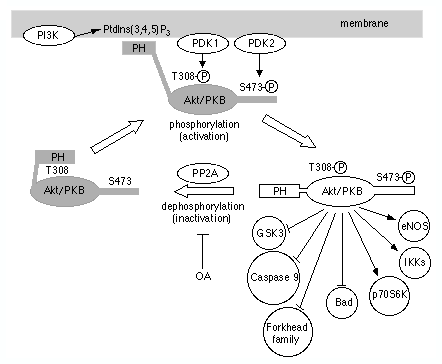DEFINITION
Akt/PKB is a serine/threonine protein kinase that plays a key role in multiple cellular processes such as glucose metabolism, cell proliferation, apoptosis, transcription and cell migration.
THE GENE
CHEMICAL STRUCTURE AND IMAGES
When relevant for the function
- Primary structure
- Secondary structure
- Tertiary structure
- Quaternary structure
Protein Aminoacids Percentage
The Protein Aminoacids Percentage gives useful information on the local environment and the metabolic status of the cell (starvation, lack of essential AA, hypoxia)
Protein Aminoacids Percentage (Width 700 px)


The high ratio Glu/Gln points to a late evolutionary protein
SYNTHESIS AND TURNOVER
mRNA synthesis
protein synthesis
post-translational modifications
degradation
CELLULAR FUNCTIONS
cellular localization,

biological function
- Cell signaling and Ligand transport
 * Structural proteins
* Structural proteins
REGULATION
Mol Cell. 2010 Aug 27;39(4):493-506.
STAT3 activation of miR-21 and miR-181b-1 via PTEN and CYLD are part of the epigenetic switch linking inflammation to cancer. 2010
Iliopoulos D, Jaeger SA, Hirsch HA, Bulyk ML, Struhl K.
Department of Biological Chemistry and Molecular Pharmacology, Harvard Medical School, Boston, MA 02115, USA.
Abstract
A transient inflammatory signal can initiate an epigenetic switch from nontransformed to cancer cells via a positive feedback loop involving NF-kappaB, Lin28, let-7, and IL-6. We identify differentially regulated microRNAs important for this switch and putative transcription factor binding sites in their promoters. STAT3, a transcription factor activated by IL-6, directly activates miR-21 and miR-181b-1. Remarkably, transient expression of either microRNA induces the epigenetic switch. MiR-21 and miR-181b-1, respectively, inhibit PTEN and CYLD tumor suppressors, leading to increased NF-kappaB activity required to maintain the transformed state. These STAT3-mediated regulatory circuits are required for the transformed state in diverse cell lines and tumor growth in xenografts, and their transcriptional signatures are observed in colon adenocarcinomas. Thus, STAT3 is not only a downstream target of IL-6 but, with miR-21, miR-181b-1, PTEN, and CYLD, is part of the positive feedback loop that underlies the epigenetic switch that links inflammation to cancer.
mir-21
mir-199-1

AKT-ing via microRNA 2010 Fulltext
DIAGNOSTIC USE